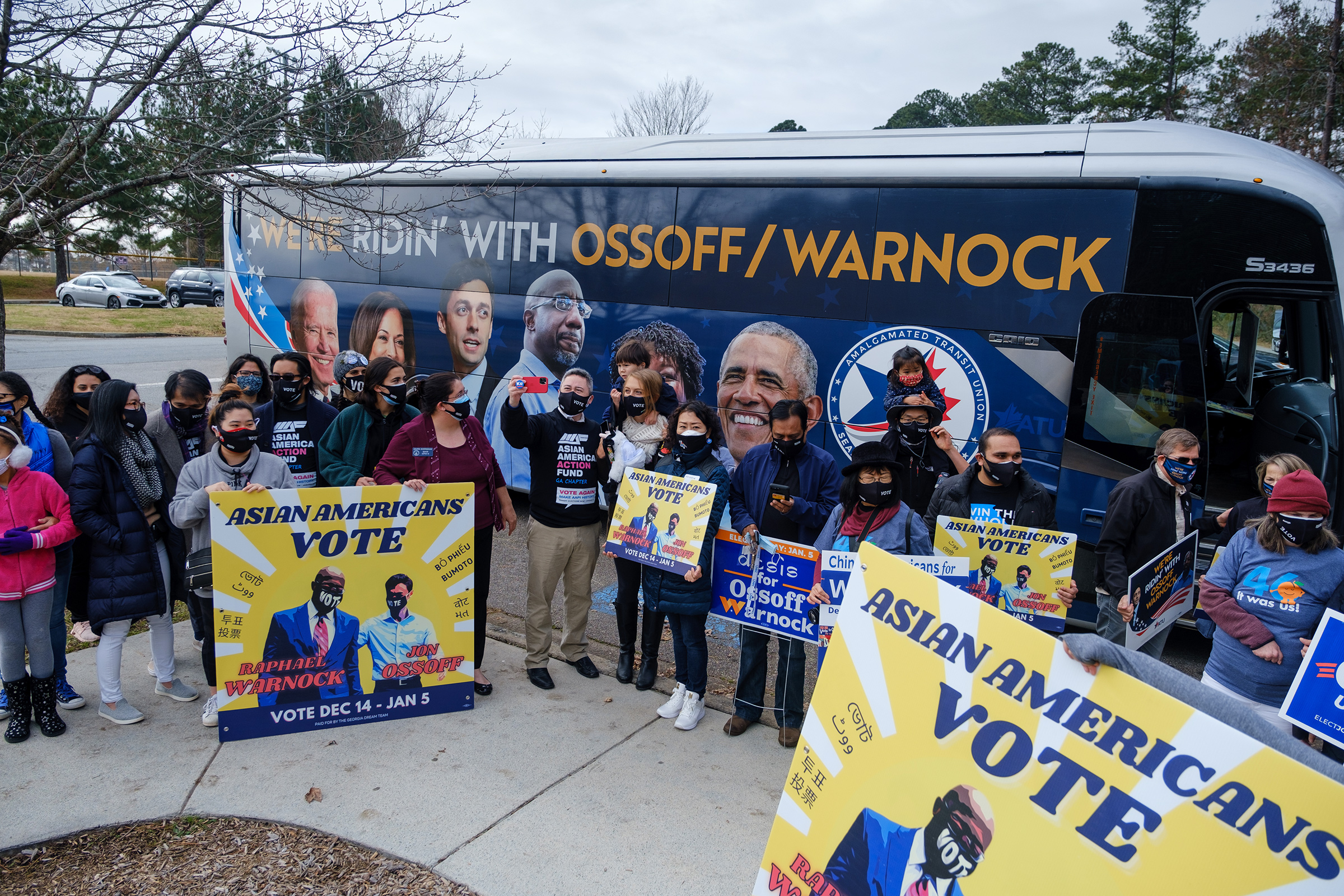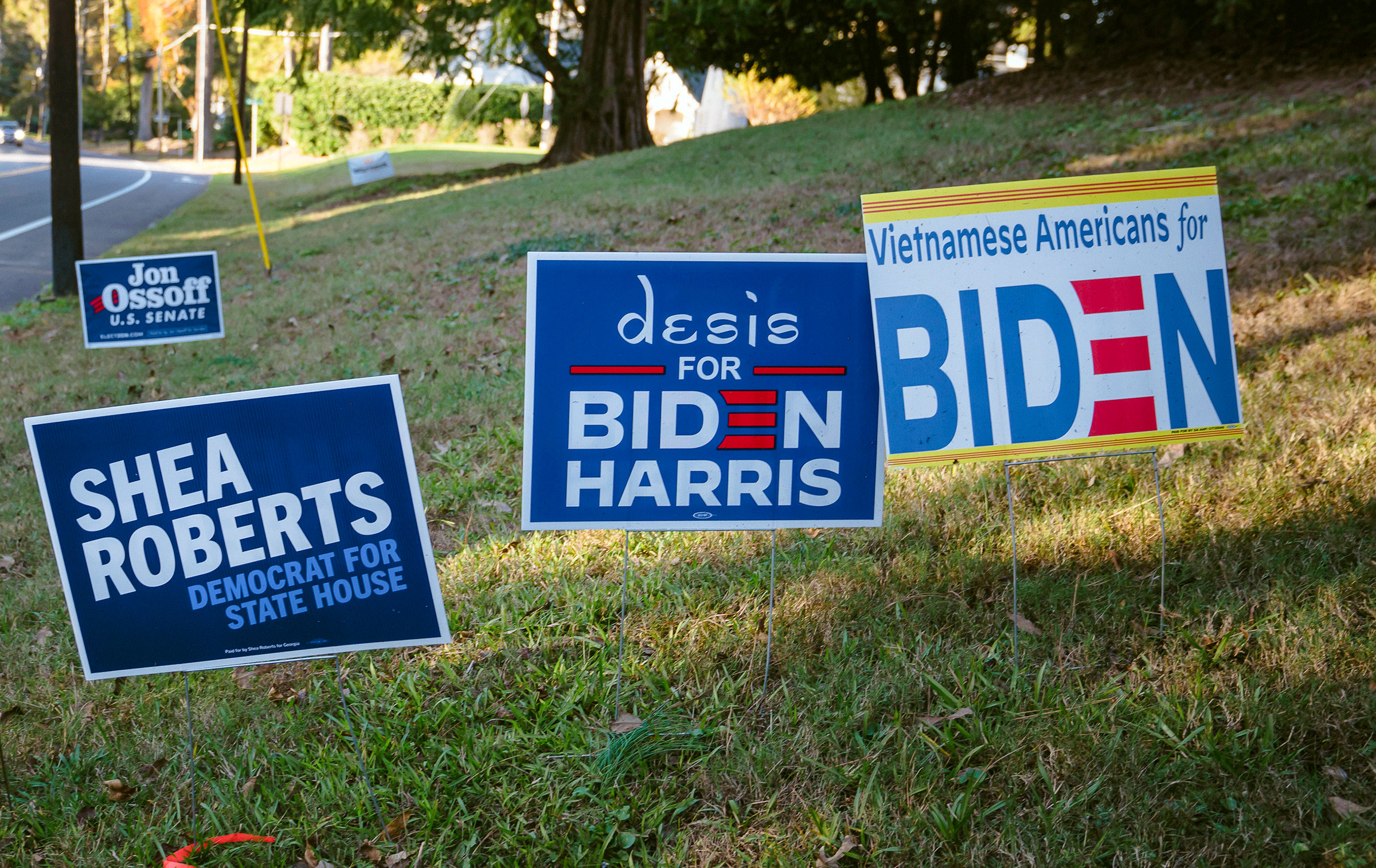
On Nov. 3, Soon Woo Kwon stayed up late watching the news, eager to find out the results of the first American election he voted in. Kwon, who has been living in Georgia for 13 years, immigrated to the United States from South Korea in 2007, and when he finally became a naturalized citizen this year, he was excited to exercise his new right. “Now, I feel like I’m really living in the United States as a citizen,” he says. “I’m just one of the voters, but I was able to share my voice with the people.”
Kwon is one of Georgia’s roughly 140,000 Asian American and Pacific Islander (AAPI) voters who turned out in record numbers in the 2020 presidential election. AAPI turnout in the Peach State nearly doubled this year from 2016, a rate of growth faster than Black, white, or Latino voters in the state. According to exit polls, nearly seven out of 10 of those voters cast their ballots for the Biden-Harris ticket. With President-elect Joe Biden winning Georgia by just about 12,000 votes, their vote helped swing the state for Democrats, observers say.
The surge in turnout was no accident. Politicians on both ends of the political spectrum are waking up to the importance of AAPI voters. They are the fastest-growing racial or ethnic group in the nation’s voting-eligible population. One in five AAPI voters across the United States were first-time voters in the 2020 election. In Georgia, where they comprise about 3% of the electorate, voter organizations and advocacy groups worked tirelessly to mobilize AAPI voters, who say they’ve been ignored by politicians and parties for years.
That effort continues ahead of Georgia’s Jan. 5 runoffs, which will determine whether Democrats take or Republicans continue to control the Senate. In the past 30 years, Democrats have only won one of eight statewide runoffs in general or special elections in Georgia, according to Inside Elections. Voter groups and Democratic campaigns alike are scrambling to ensure that Georgia’s AAPI population turns up to the polls a second time.
“Our work is going to be even more important to help convince them that, ‘Yes, you just voted last month, but this election is important and we need you to come back and do it again,'” says Aisha Yaqoob Mahmood, executive director of the Asian American Advocacy Fund.
‘We have to do it for ourselves.’
Though turnout was strong for the 2020 election, AAPI communities have not historically been prioritized by politicians, researchers say. “For as long as we’ve collected data on this, it has been the case that AAPI eligible voters are less likely to have been contacted by a campaign or candidate than others,” says Taeku Lee, a political science professor at the University of California, Berkeley. Compared to white or Black voters, that gap in outreach can be up to 10 percentage points.
That has real consequences when it comes to participation, says Brad Jenkins, former Obama White House Associate Director and co-founder of the RUN AAPI political advocacy group. In September, RUN AAPI released the first-ever political opinion poll focused exclusively on Asian Americans between the ages of 18 and 34. One of the biggest barriers to their voting participation, the poll found, was a lack of motivation. Forty-two percent of participants responded that they experienced at least one of three motivational barriers: that they didn’t think their vote made a difference, that they didn’t care about politics, or that they had no candidates to vote for.
“It comes down to the lack of investment and really the lack of prioritizing and focusing on this community,” says Jenkins. “If you don’t feel seen, if you don’t feel heard, then you’re not going to feel like you have power.”
In the past, false presumptions — for instance, that AAPIs were too small a voter group to be worth investing in, or are “low-propensity voters” because they are newly naturalized citizens — might have informed why candidates or campaigns did not focus on AAPI outreach, says Lee. These misconceived views are especially hard to shake, “when the inner circles of campaigns do not reflect the diversity in the electorate, as has been the case too often in the past,” he adds.
In an effort to galvanize young AAPI voters across the country before this year’s general election, Jenkins launched #TheNew campaign with actor Chloe Bennett, hosting text banks and circulating voting information on social media. The campaign also released a video featuring a number of prominent community members and supporters, including Taika Waititi, Harry Shum Jr, Alexander Wang and Cory Booker, encouraging people to vote. “We can’t just wait for a lot of old white men who run the sort of traditional advertising agencies or political super PACs, who time and time again always ignore our community,” says Jenkins. “We have to do it ourselves. We can’t wait for anyone to do it for us.”

AAPI voters are not a monolith; the umbrella term accounts for more than 30 different ethnic subgroups and reflects a wide range in cultural practices, native languages, values and political inclinations. Vietnamese Americans, for instance, are far more likely to lean Republican compared to other Asian American subgroups, according to a survey by AAPI Data, and Indian Americans, after years of being reliably Democratic voters, have started to shift right. Voter turnout rates across different AAPI subgroups vary as well.
Organizers say as the broader group’s political clout grows, outreach to its members will need to get more focused. “I think if there was a way for Indian canvassers to target Indian households, Korean canvassers to target Korean households, and so on, it would have an even more amplified effect,” says Mindy Kao, a canvasser in Georgia. “My parents are from Taiwan, so if there was some way in which I could be sent to Chinese households, I feel like I could connect more.”
‘The difference between winning and losing.’
In Georgia, organizers and canvassers like Kao were successful in getting out the AAPI vote in November by drawing on those cultural connections, sending AAPI canvassers out to AAPI households, stressing the importance of their votes and getting voting information into the relevant local language media. Michael Park, who works with the nonpartisan group Korean American Coalition Metro Atlanta, helped place registration information, candidate profiles and key voting dates in local editions of Korean-language newspapers, such as the Chosun Daily and The Korea Times, and in KTN, the Korean television network.
Getting Georgia voters to show up twice in such high numbers will be harder, organizers say. Many voters have election fatigue, says Lee, after an intense and drawn-out election. And generally, any kind of runoff tends to have lower participation than the first round. “Across the board, runoffs in Georgia have a really bad track record of turnout,” says the Asian American Advocacy Fund’s Mahmood. “People just don’t turnout in the same numbers.”
And the same barriers that organizers had to overcome to reach AAPI voters in November will have to be tackled again. Despite some groups’ efforts, only half of AAPI voters in Georgia’s 7th congressional district had access to election material in an Asian language they spoke in November, according to an election-week poll that Lee conducted. “Language access is a seemingly small and simple way to ensure participation, but for too many AAPI registered voters, it remains elusive,” he says.
Recent poll closures could pose another major challenge. On December 10, election officials in Forsyth county, where Kwon voted, announced the closure of six early voting locations that were in service in November. Since AAPI voters cast their ballots early in large numbers during the general election, voter rights groups say the closures could reduce the number of AAPI voters who participate.
The Democratic Senate campaigns are already paying attention to this critical demographic in the run-up to Jan. 5. Both Democratic candidates Jon Ossoff and Raphael Warnock have campaign staff dedicated to AAPI outreach. Warnock’s campaign has released in-language ads in Chinese, Korean and South Asian media outlets, and hosted several events and rallies for AAPI voters.
Ossoff’s team has made over 100,000 calls to AAPI voters since the start of the runoff campaign and has staffed up on Mandarin-speaking organizers who communicate with voters to inform them of deadlines and candidates up and down the ballot. Ossoff’s campaign cited Stacey Abrams, who hired a dedicated staff member to reach out to the AAPI community during her 2018 run for governor, as a source of inspiration for reaching out to lower propensity voters in communities of color, whatever their voting history.
Republican candidates Senators Kelly Loeffler and David Perdue did not respond to requests for comment.
With just a few weeks to go, Lee says no campaign should take AAPI voters for granted. “The 2020 presidential race was decided by a mere 12,000 votes,” he says. “It’s safe to say that a high AAPI turnout versus a low AAPI turnout could be the difference between winning and losing.”
More Must-Reads From TIME
- Dua Lipa Manifested All of This
- Exclusive: Google Workers Revolt Over $1.2 Billion Contract With Israel
- Stop Looking for Your Forever Home
- The Sympathizer Counters 50 Years of Hollywood Vietnam War Narratives
- The Bliss of Seeing the Eclipse From Cleveland
- Hormonal Birth Control Doesn’t Deserve Its Bad Reputation
- The Best TV Shows to Watch on Peacock
- Want Weekly Recs on What to Watch, Read, and More? Sign Up for Worth Your Time
Write to Anna Purna Kambhampaty at Anna.kambhampaty@time.com
